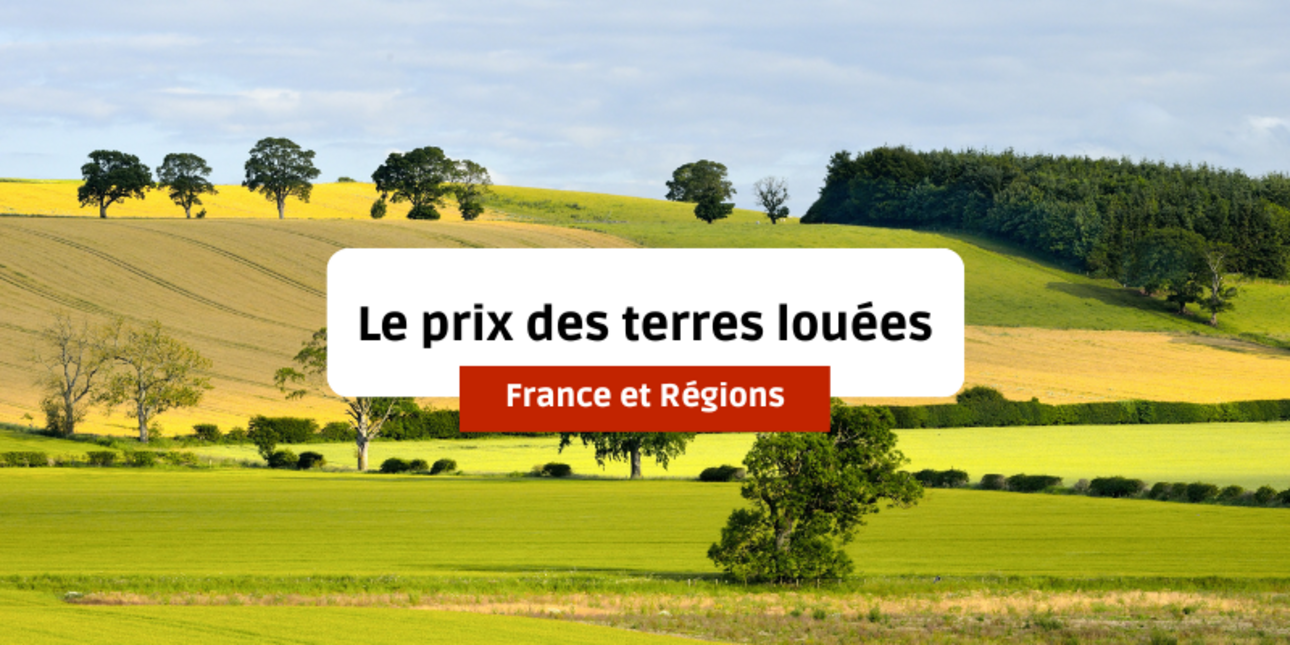
Updated on 10 septembre 2025
In addition to our article on the sale price of land in France, this article looks at changes in the sale price of leased land since 2012.
On average, a hectare of rented land will have a market value in 2024 of €5,220, compared with €6,400 for land available for rent, a discount of 18%.
This price is 2% higher than in 2022.
The difference in value between leased and unleased land is narrowing year on year (it was 26% in 2015 and 25% in 2012), a sign of the current attractiveness of agricultural land.
The increase in the average sale price of leased land has almost kept the value of land holdings in line with inflation since 2012 (26%):
| Région | 2012 | 2013 | 2014 | 2015 | 2016 | 2017 | 2018 | 2019 | 2020 | 2021 | 2022 | 2023 | 2024 | 2024/2023 | 2024/2012 |
| Auvergne-Rhône-Alpes | 3 430 € | 3 550 € | 3 570 € | 3 590 € | 3 580 € | 3 570 € | 3 810 € | 3 670 € | 3 840 € | 3 800 € | 3 870 € | 4 010 € | 3 940 € | -1,7% | 15% |
| Bourgogne-Franche-Comté | 2 450 € | 2 520 € | 2 590 € | 2 600 € | 2 580 € | 2 610 € | 2 620 € | 2 610 € | 2 650 € | 2 560 € | 2 650 € | 2 760 € | 2 670 € | -3,3% | 9% |
| Bretagne | 4 050 € | 4 160 € | 4 280 € | 4 420 € | 4 560 € | 4 580 € | 4 590 € | 4 660 € | 4 830 € | 4 830 € | 4 920 € | 5 130 € | 5 170 € | 0,8% | 28% |
| Centre-Val de Loire | 4 340 € | 4 260 € | 4 650 € | 4 570 € | 4 820 € | 4 930 € | 5 010 € | 5 030 € | 5 150 € | 5 080 € | 5 430 € | 5 400 € | 5 580 € | 3,3% | 29% |
| Corse | Manque de données | ||||||||||||||
| Grand Est | 5 480 € | 5 860 € | 5 980 € | 6 220 € | 6 100 € | 6 450 € | 6 330 € | 6 400 € | 6 580 € | 6 660 € | 6 720 € | 6 500 € | 6 620 € | 1,8% | 21% |
| Hauts-de-France | 5 000 € | 5 310 € | 5 460 € | 5 730 € | 5 870 € | 6 150 € | 6 310 € | 6 280 € | 6 520 € | 6 640 € | 6 880 € | 7 050 € | 7 230 € | 2,6% | 45% |
| Ile-de-France | 5 420 € | 5 930 € | 6 020 € | 5 750 € | 5 790 € | 6 490 € | 6 060 € | 6 210 € | 6 640 € | 6 570 € | 6 640 € | 6 640 € | 6 660 € | 0,3% | 23% |
| Normandie | 5 750 € | 5 890 € | 6 410 € | 6 570 € | 6 690 € | 6 700 € | 6 940 € | 7 050 € | 7 540 € | 7 330 € | 7 500 € | 7 910 € | 8 200 € | 3,7% | 43% |
| Nouvelle-Aquitaine | 2 990 € | 3 240 € | 3 290 € | 3 230 € | 3 420 € | 3 490 € | 3 480 € | 3 540 € | 3 620 € | 3 590 € | 3 720 € | 3 670 € | 3 770 € | 2,7% | 26% |
| Occitanie | Manque de données | ||||||||||||||
| Pays de la Loire | 2 620 € | 2 750 € | 2 860 € | 2 810 € | 2 910 € | 2 910 € | 3 040 € | 3 050 € | 3 060 € | 3 110 € | 3 180 € | 3 290 € | 3 340 € | 1,5% | 21% |
| Provence-Alpes-Cote d'Azur | Manque de données | ||||||||||||||
| France Métropolitaine | 4 060 € | 4 240 € | 4 410 € | 4 470 € | 4 550 € | 4 690 € | 4 740 € | 4 760 € | 4 930 € | 4 910 € | 5 060 € | 5 120 € | 5 220 € | 2% | 25% |

The price of leased land is usually lower than the price of free land. This is due to the particularities of the rural lease system.
When agricultural land is rented under a rural lease, the farmer is in place for a minimum of 9 years and also benefits from a right to renewal at the end of the lease. Apart from cases where the farmer retires, the lessor takes over the farm (under certain conditions), or where there is a fault in the execution of the lease, the lease is intended to continue. The desire to sell the land is not, for the landowner, a valid reason for not renewing the lease.
Therefore, where the land is leased, the lessor who wishes to sell may do so:
And the farmer will always have a preferential right to buy the land and can also appeal to the Tribunal Paritaire des Baux Ruraux if the proposed transfer price seems excessive.
In practice, this complex legal situation results in a discount of up to 30% compared to the price of free land in some regions.
Buying farmland for an investor is an investment that has advantages but also constraints.
In summary, investment in agricultural land can be of interest to the estate. The characteristics of this type of asset must be taken into account, as well as the asset situation and objectives of each individual.
| Région | 2012 | 2013 | 2014 | 2015 | 2016 | 2017 | 2018 | 2019 | 2020 | 2021 | 2022 | 2023 | 2022/2012 |
| Auvergne-Rhône-Alpes | 3 430 | 3 550 | 3 570 | 3 590 | 3 580 | 3 570 | 3 810 | 3 670 | 3 840 | 3 800 | 3 870 | 4 010 | 17% |
| Bourgogne-Franche-Comté | 2 450 | 2 520 | 2 590 | 2 600 | 2 580 | 2 610 | 2 620 | 2 610 | 2 650 | 2 560 | 2 650 | 2 760 | 13% |
| Bretagne | 4 050 | 4 160 | 4 280 | 4 420 | 4 560 | 4 580 | 4 590 | 4 660 | 4 830 | 4 830 | 4 920 | 5 130 | 27% |
| Centre-Val de Loire | 4 340 | 4 260 | 4 650 | 4 570 | 4 820 | 4 930 | 5 010 | 5 030 | 5 150 | 5 080 | 5 430 | 5 400 | 24% |
| Grand Est | 5 480 | 5 860 | 5 980 | 6 220 | 6 100 | 6 450 | 6 330 | 6 400 | 6 580 | 6 660 | 6 720 | 6 500 | 19% |
| Hauts-de-France | 5 000 | 5 310 | 5 460 | 5 730 | 5 870 | 6 150 | 6 310 | 6 280 | 6 520 | 6 640 | 6 880 | 7 050 | 41% |
| Ile-de-France | 5 420 | 5 930 | 6 020 | 5 750 | 5 790 | 6 490 | 6 060 | 6 210 | 6 640 | 6 570 | 6 640 | 6 640 | 23% |
| Normandie | 5 750 | 5 890 | 6 410 | 6 570 | 6 690 | 6 700 | 6 940 | 7 050 | 7 540 | 7 330 | 7 500 | 7 910 | 38% |
| Nouvelle-Aquitaine | 2 990 | 3 240 | 3 290 | 3 230 | 3 420 | 3 490 | 3 480 | 3 540 | 3 620 | 3 590 | 3 720 | 3 670 | 23% |
| Occitanie | Manque de données | ||||||||||||
| Pays de la Loire | 2 620 | 2 750 | 2 860 | 2 810 | 2 910 | 2 910 | 3 040 | 3 050 | 3 060 | 3 110 | 3 180 | 3 290 | 21% |
| Provence-Alpes-Cote d'Azur | Manque de données | ||||||||||||
| France Métropolitaine | 4 060 | 4 240 | 4 410 | 4 470 | 4 550 | 4 690 | 4 740 | 4 760 | 4930 | 4910 | 5060 | 5120 | 25% |
Source : SAFER 2024 - Barème indicatif de la valeur vénale des terres du Ministère de l'agriculture.
You will find articles on land prices in France :
We also publish articles and tables showing price trends by region, department and agricultural zone:
We also devote articles to the price of vines in France and in the various vineyards.